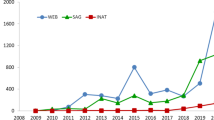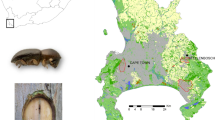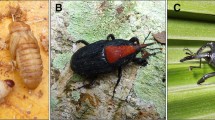Abstract
The spread of the red palm weevil is now a very severe problem on a global scale. In this paper, we investigate its spread during the 2007–2013 period in a coastal urban area characterized by a high density of palm trees, and discuss the application of a new approach to data collection and processing. While most works on the spread of the red palm weevil are based upon geo-referenced traps, we focused on the health of each palm, considering the surrounding territorial context. To this end, we used historical aerial photos, freely available remote sensing images and field surveys, integrated in a GIS environment to analyze the extent and mode of pest spread over time. Our results show that the exponential increase of new cases for each new year is regulated by this spatial spread model: at the early stage of infestation the red weevil tends to occupy as much space as possible, within the limitations of the distance it can fly; in the following stage, its infestation density increases in recently colonized areas. We discuss current local management of palm trees and the pests, and propose strategies that take into account both the ecology of the red weevil and the territorial context. Finally, we encourage the provision of more resources for early detection and prevention measures, as well as replacement of the dead Phoenix canariensis palms with a greater variety of species, as a varied composition would be less prone to pest-caused depopulation.











Similar content being viewed by others
References
Abbas MST, Hanounik SB, Shahdad AS, Ai-Bagham SA (2006) Aggregation pheromone traps, a major component of IPM strategy for the red palm weevil, Rhynchophorus ferrugineus in date palms (Coleoptera: Curculionidae). J Pest Sci 79:69–73. https://doi.org/10.1007/s10340-005-0113-6
Abe F, Ohkusu M, Kubo T, Kawamoto S, Sone K, Hata K (2010) Isolation of yeasts from palm tissues damaged by the red palm weevil and their possible effect on the weevil overwintering. Mycoscience 51(3):215–223. https://doi.org/10.1007/s10267-009-0029-8
Abraham VA, Nair SS, Nair CPR (1999) A comparative study on the efficacy of pheromone lures in trapping Rhynchophorus ferrugineus in coconut gardens. Indian Coconut Journal Cochin 30:1–2
Al-Dosary NM, Al-Dobai S, Faleiro JR (2016) Review on the management of red palm weevil Rhynchophorus ferrugineus olivier in date palm Phoenix dactylifera L. Emirates Journal of Food and Agriculture 28(1):34–44. https://doi.org/10.9755/ejfa.2015-10-897
Alpizar D, Fallas M, Oehlschlager AC, Gonzalez ML, Chinchilla CL, Bulgarelli J (2002) Pheromone mass trapping of the West Indian sugarcane weevil and the American palm weevil (Coleoptera, Curculionidae) in palmetto palm. Fla Entomol 85(3):426–430
Ávalos JA, Borriàs M, Soto A (2011) Aportaciones sobre el comportamiento de adultos de Rhynchophorus ferrugineus mediante el anàlisis de sus capturas en trampas. Phytoma Espana 226:20–22
Ávalos JA, Marti-Campoy A, Soto A (2014) Study of the flying ability of Rhynchophorus ferrugineus (Coleoptera: Dryophthoridae) adults using a computer-monitored flight mill. Bull Entom Res 104:462–470. https://doi.org/10.1017/S0007485314000121
Ávalos JA, Balasch S, Soto A (2016) Flight behaviour and dispersal of Rhynchophorus ferrugineus (Coleoptera: Dryophthoridae) adults using mark-release-recapture method. Bulletin of Entomological Research -May 2016, Page 1 of 9. 10.1017/S0007485316000341
Barranco P, Lorente-Moreno F, Alcazar-Alba MD, Pena-Mendez YJ (2006). Control of Rhynchophorus ferrugineus in Spain: field tests and treatments. Proc. 1st International Workshop on Red Palm Weevil. IVIA, Valencia, Spain, 2005, 180 pp
Blumberg D (2008) Review: date palm arthropod pests and their management in Israel. Phytoparasitica 36(5):411–448. https://doi.org/10.1007/BF03020290
Brun L (2006). The date palm in Egypt: a traditional cash crop threatened by the Red Palm Weevil. Proc. 1st International Workshop on Red Palm Weevil. IVIA, Valencia, 2005, 180 pp
Chefaoui RM, Hortal JN, Lobo JM (2005) Potential distribution modelling, niche characterization and conservation status assessment using GIS tools: a case study of Iberian Copris species. Biol Conserv 122:327–338. https://doi.org/10.1016/j.biocon.2004.08.005
Conti F, Sesto F, Raciti E, Tamburino V, Longo S (2008) Ecological factors affecting the spread of Rhynchophorus ferrugineus (Red palm weevil) in eastern Sicily. Plms 52:127–132
Cox ML (1993) Red palm weevil, Rhynchophorus ferrugineus in Egypt. FAO Plant Protection Bulletin 41(1):30–31
Dembilio O, Jacas JA (2011) Basic bio-ecological parameters of the invasive Red palm weevil, Rhynchophorus ferrugineus (Coleoptera: Curculionidae), in Phoenix canariensis under Mediterranean climate. Bull Entomol Res 101(2):153–163. https://doi.org/10.1017/S0007485310000283
DM 09/11/2007 Decreto Ministeriale (2007) – Disposizioni sulla lotta obbligatoria contro il punteruolo rosso della palma Rhynchophorus ferrugineus (Olivier). Recepimento della Decisione della Commissione 2007/365/EC. Gazzetta Ufficiale, Serie Generale 37, del 13-2-2008 (in Italian). http://www.guritel.it/free-sum/ARTI/2008/02/13/sommario.html [accessed on 12 April 2011]
DM 07/02/2011 Decreto Ministeriale 7 febbraio (2011) – Misure di emergenza per il controllo del Punteruolo rosso della palma Rhynchophorus ferrugineus (Olivier). Recepimento decisione della Commissione 2007/ 365 /CE e sue modifiche. Gazzetta Ufficiale, Serie Generale 36, del 14-2-2011 (in Italian). http://www.guritel.it/free-sum/ARTI/2011/02/14/sommario.html [accessed on 12 April 2011]
Ebdon D (1985) Statistics in Geography. Blackwell
El Garhy ME (1996). Field evaluation of the aggregation pheromone of Rhynchophorus ferrugineus in Egypt. In Brighton Crop Protection: Pests and Diseases, vol. 3:1059–1064. BCPC, Farnham (GB)
El-Sebay Y (2003) Ecological studies on the Red palm weevil, Rhynchophorus ferrugineus (Coleoptera: Curculionidae) in Egypt. Egypt J Agric Res 81:523–529
EPPO Reporting Service (1996). Introduction of the Asiatic palm weevil, Rhynchophorus ferrugineus into Spain. 96 / 096, No 05
EPPO Reporting Service (1999a). First report of Rhynchophorus ferrugineus in Jordan. 99 / 78, No 05
EPPO Reporting Service (1999b). First report of Rhynchophorus ferrugineus in Israel. 99 / 119, No 07
EPPO Reporting Service (2004). Rhynchophorus ferrugineus found in Comunidad Valenciana, Spain. 2004 / 60, No 04
EPPO Reporting Service (2006a). First report of Rhynchophorus ferrugineus in Italy. 2006 / 001, No 1
EPPO Reporting Service (2006b). Details on Rhynchophorus ferrugineus in Sicilia (Italy). 2006 / 028, No 2
EPPO Reporting Service (2006c). Rhynchophorus ferrugineus found in Lazio region, Italy. 2006 / 227, No 11
EPPO Reporting Service (2007a). First report of Rhynchophorus ferrugineus in Turkey. 2007 / 001, No 1
EPPO Reporting Service (2007b). First report of Rhynchophorus ferrugineus in Syria. 2007 / 002, No 1
EPPO Reporting Service (2007c). Further reports of Rhynchophorus ferrugineus in Puglia and Sardegna, Italy. 2007 / 003, No 1
EPPO Reporting Service (2007d). First report of Rhynchophorus ferrugineus in Cyprus. 2007 / 022, No 2
EPPO Reporting Service (2007e). Situation of Rhynchophorus ferrugineus in Spain. 2007 / 023, No 2
EPPO Reporting Service (2008a). First report of Rhynchophorus ferrugineus in Portugal. 2008 / 022, No 2
EPPO Reporting Service (2008b). Further details on the situation of Rhynchophorus ferrugineus in Puglia and Saregna, Italy. 2008 / 093, No 5
EPPO Reporting Service (2009). First report of Rhynchophorus ferrugineus in Albania. 2009 / 207, No 11
EPPO Reporting Service (2010a). Situation of Rhynchophorus ferrugineus in Italy in 2009. 2010 / 139, No 8
EPPO Reporting Service (2010b). Rhynchophorus ferrugineus occurs in Malta. 2010 / 204, No 11
EPPO/OEPP (2013). PQR-EPPO Database on quarantine pets. (http://www.eppo.int )
EU (2007). Decision 2007/365/EC – Commission Decision of 25 May 2007 on emergency measures to prevent the introduction into and the spread within the Community of Rhynchophorus ferrugineus (Olivier). http://eur-lex.europa.eu/LexUriServ/LexUriServ.do?uri=CONSLEG:2007D0365:20081007:EN:PDF [accessed on 12 April 2011]
EPPO (2008) Data sheet on quarantine pests Rhynchophorus ferrugineus. European and Mediterranean Plant Protection Organization Bulletin 38:55–59
EU (2008) Decision 2008/776/EC – Commission Decision of 6 October 2008 amending Decision 2007/365/EC on emergency measures to prevent the introduction into and the spread within the Community of Rhynchophorus ferrugineus (Olivier). http://eur-lex.europa.eu/LexUriServ/LexUriServ.do?uri=OJ:L:2008:266:0014:0014:EN:PDF [accessed on 12 April 2011]
EU (2010) Decision 2010 / 467 / EU – Commission Decision of 17 August 2010 amending Decision 2007 / 365 / EC as regards the susceptible plants and the measures to be taken in cases where Rhynchophorus ferrugineus (Olivier) is detected. http://eur-lex.europa.eu/LexUriServ/LexUriServ.do?uri=OJ:L:2010:226:0042:0045:EN:PDF [accessed on 12 April 2011]
ESRI (2012) ArcGIS 10.X. Redlands: Environmental Systems Research Institute ESRI. GIS mapping Software, Solutions, Services, map Apps, and Data. http://www.esri.com/. Accessed May 2015
Faleiro JR, Chellapan M (1999) Attraction of Rhynchophorus ferrugineus to ferrugineol based pheromone lures in coconut gardens. J Trop Agric 37:60–63
Faleiro JR, Ashok Kumar J, Rangnekar PA (2002) Spatial distribution of red palm weevil Rhynchophorus ferrugineus Oliv. (Coleoptera: Curculionidae) in coconut plantations. Crop Prot 21:171–176
Faleiro JR (2006) A review of the issues and management of the red palm weevil Rhynchophorus ferrugineus (Coleoptera: Rhynchophoridae) in coconut and date palm during the last one hundred years. International Journal of Tropical Insect Science 26(3):135–154. https://doi.org/10.1079/IJT2006113
Ferry M (2019) The world situation and the main lessons of 30 years of fight against the red palm weevil. Arab Journal of Plant Protection 37(2):109–118
Gunawardena NE, Kern F, Janssen E, Meegoda C, Schafer D, Vostrowsky O, Bestmann HJ (1998) Host attractants for red weevil, Rhynchophorus ferrugineus: identification, electrophysiological activity, and laboratory bioassay. J Chem Ecol 24:425–437
Hallett RH, Oehlschlager AC, Borden JH (1999) Pheromone trapping protocols for Rhynchophorus ferrugineus. International Journal of Pest Management 45:231–237
Hunter MD (2002) Landscape structure, habitat fragmentation, and the ecology of insects. Agric For Entomol 4:159–166. https://doi.org/10.1046/j.1461-9563.2002.00152.x
La Mantia G, Lo Verde G, Ferry M (2008) Le palme colpite da punteruolo risanate con la dendrochirurgia. L’Informatore Agrario 35:43–45 (in Italian)
Lausch A, Heurich M, Fahse L (2013) Spatio-temporal infestation patterns of Ips typographus (L.) in the Bavarian Forest National Park, Germany. Ecol Indic 31:73–81
Longo S, Tamburino V (2005) Gravi infestazioni di punteruolo rosso della palma. L’Informatore Agrario 50:73–74 (in Italian)
Maheswari TU, Rao NV (2000) Trapping of Rhynchophorus ferrugineus with pheromone trap. Insect Environment 6:76–77
Massa R, Caprio E, Migliore MD, Panariello G, Pinchera D, Griffo R (2010) Punteruolo rosso delle palme: la soluzione delle microonde. Terra e Vita 46:10–13 (in Italian)
Massoud MA, Faleiro JR, El-Saad MA, Sultan E (2011) Geographic information system used for assessing the activity of the Red Palm Weevil (Rhynchophorus ferrugineus Olivier) in the date palm oasis of Al-Hassa. Saudi Arabia J Plant Prot Res 51:234–239. https://doi.org/10.1017/S174275841200015X
Mitchell A (2005) ESRI Guide to GIS Analysis (Vol. 2): Spatial Measurement & Statistics. ESRI Press, Redlands
Murphy S, Briscoe B (1999) The Red palm weevil as an alien invasive: biology and the prospects for biological control as a component of IPM. BioControl 20:35–45
Nardi S, Ricci E, Lozzi R, Marozzi F, Ladurner E, Chiabrando F, Granchelli L, Verdolini E, Isidoro N, Riolo P (2011) Bulletin OEPP/EPPO Bulletin 41:103–115
Nguyen HDD, Nansen C (2018) Edge-biased distribution of insects. A review Agron Sustain Dev 38:11. https://doi.org/10.1007/s13593-018-0488-4
Oehlschlager AC, Chinchilla C, Castillo G, Gonzalez L (2002) Control of Red Ring Disease by mass trapping of Rhynchophorus palmarum (Coleoptera: Curculionidae). Fla Entomol 85(3):507–513. https://doi.org/10.1653/0015-4040(2002)085[0507:CORRDB]2.0.CO;2
Odum EP, Barrett GW (2005) Fundamentals of Ecology (5° ed.). Belmont: Thomson Brooks/Cole, (Chapter 7)
Papadopoulos NT, Katsoyannos BI, Nestel D (2003) Spatial autocorrelation analysis of a Ceratitis capitata (Diptera: Tephritidae) adult population in a mixed deciduous fruit orchard in northern Greece. Environ Entomol 32:319–326. https://doi.org/10.1603/0046-225X-32.2.319
Peri E, Rochat D, Belušič G, Ilić M, Soroker V, Barkan S, Guarino S, Lo Bue P, Colazza S (2016) Rhynchophorus ferrugineus: behavior, ecology, and communication. In: Wiley J & Sons (ed) Handbook of Major Palm Pests: Biology and Management, pp 105–130. https://doi.org/10.1002/9781119057468
Pitt J, Worner SP (2007). Modelling invasive species spread using stochastic, high resolution, spatially explicit dispersal models integrated within a Geographic Information System. APHIS Science Panel on Pest Risk Mapping, Fort Collins, Colorado, June 5–7th, 2007
Pontikakos CM, Kontodimas DC, Tsiligiridis T (2015) A location aware system for integrated management of Rhynchophorus ferrugineus in urban systems. Comput Environ Urban Syst 50:74–88. https://doi.org/10.1016/j.compenvurbsys.2014.11.005
Rajapakse CNK, Gunawardena NE, Perena KFG (1998) Pheromone baited trap for the management of Rhynchophorus ferrugineus populations in coconut plantations. Cocos 13:54–65
Sacchetti P, Camèra A, Granchietti A, Rosi M, Marzialetti P (2005) Prima segnalazione in Italia del curculionide delle palme, Rhyncophorus ferrugineus. Notiziario del Centro Sperimentale per il Vivaismo di Pistoia 144(5–6):6–9 (in Italian)
Sciarretta A, Trematerra P, Baumgartner J (2001) Geostatistical analysis of Cydia funebrana (Lepidoptera: Tortricidae) pheromone trap catches at two spatial scales. Am Entomol 47:174–184. https://doi.org/10.1093/ae/47.3.174
Sciarretta A, Zinni A, Mazzocchetti A, Trematerra P (2008) Spatial Analysis of Lobesia botrana (Denis and Schiffermüller) male population in a Mediterranean agricultural landscape in central Italy. Environ Entomol 37(2):382–390. https://doi.org/10.1603/0046-225X(2008)37[382:SAOLBL]2.0.CO;2
Sciarretta A, Trematerra P (2011) Spatio-temporal distribution of Ceratitis capitata population in a heterogeneous landscape in Central Italy. J Appl Entomol 135:241–251. https://doi.org/10.1111/j.1439-0418.2010.01515.x
Soroker V, Blumberg D, Haberman A, Hamburger-Rishard M, Reneh S, Talebaev S, Anshelevich L, Harari AR (2005) Current status of the red palm weevil infestation in date palm plantations in Israel. Phytoparasitica 33(1):97–106
Vidyasagar PSPV, Hagi M, Abozuhairah RA, Al-Mohanna OE, Al-Saihati AA (2000) Impact of mass pheromone trapping on red palm weevil: adult population and infestation level in date palm gardens of Saudi Arabia. Planter 76:347–355
Walid K (2005) Longevity, fecundity, and fertility of the red palm weevil, Rynchophorus ferrugineus Olivier (Coleoptera: Curculionidae) on natural and artificial diets. Emir J Agric Sci 17(1):23–33
Wattanapongsiri A (1966) A revision of the genera Rhynchophorus and Dynamis (Coleoptera: Curculionidae). Department of Agriculture Science Bulletin 1:1–328
Acknowledgements
This work was funded by the Plant Protection Service of Marche Region (Italy). We would like to thank Sheila Beatty for editing the English usage in the manuscript.
Author information
Authors and Affiliations
Corresponding author
Rights and permissions
About this article
Cite this article
Cinnirella, A., Bisci, C., Nardi, S. et al. Analysis of the spread of Rhynchophorus ferrugineus in an urban area, using GIS techniques: a study case in Central Italy. Urban Ecosyst 23, 255–269 (2020). https://doi.org/10.1007/s11252-019-00920-3
Published:
Issue Date:
DOI: https://doi.org/10.1007/s11252-019-00920-3




